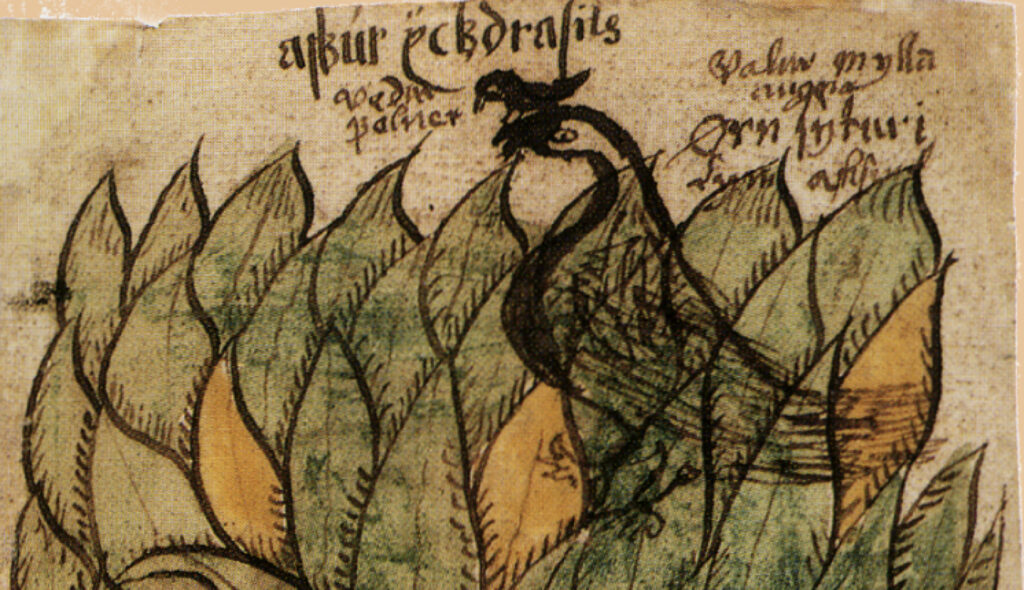I was reading the Eddas today, which is what Tolkien would probably be doing on Re(re)ading Tolkien Day, and I was struck by a pair of birdy lines:
Ǫrn mun hlakka,
slítr nái niðfǫlr.
—Vǫluspá (quoted in Snorri, Gylfaginning 50)“An eagle will shriek;
niðfǫlr, he rips into corpses.”
hlakka is “to scream like an eagle”—a new favorite verb for me, right up there with Latin drindire “to cry like a weasel”. I was pretty sure that hlakka is cognate with English clang (borrowed from Latin clangere) and Beekes backed me up on that (see his entry on Greek κλαγγή).
The noun ǫrn is just “eagle”, cognate with Old English earn/ærn. I’ve known that for years, but I suddenly wondered how that OE form yields eagle in modern English. The answer, to my surprise, is that it doesn’t. Modern English eagle is a loan-word from Norman French, ultimately stemming back to Latin aquila. But this goes to show that Everything Is Better With Latin!™—especially modern English.
But there’s a bigger question with these lines, the question that’s on everyone’s lips these days, namely, “What the hell is niðfǫlr?” It looks like a compound word from nið “the dark of the moon” and fǫlr “pale”. Old Norse loves these kennings, which are like very dense, very compact riddles/metaphors that you can figure out if you’re clever enough and your skaldic knowledge is deep enough.
Mine may not be, but I don’t think I’m alone. Faulkes renders niðfǫlr as “darkly pale” which strikes me as an oxymoron—like saying “downly-up” or “leftly-right”. Terry and Bray render niðfǫlr as “bright-beak(ed)”; I’m guessing (wildly) that they’re interpreting nið as the sickle moon, which could be construed as beaklike for kenning purposes. But nið really seems to be the dark of the moon, at least as represented by Cleasby & Vigfusson, not the sickle moon.
Maybe niðfǫlr describes something that’s pale even in the lightless darkness that follows the death of the moon, stars, and sun. In modern English, which doesn’t really do kennings, it’s hard to render that much content in one or two words, which may be how Faulkes came up with “darkly pale”.
Another thing that occurred to me is: whatever the etymology of this word, maybe it’s not an adjective at all (which is how all the editions and translations I have available render it). Maybe it’s the name of the eagle: Niðfǫlr.
Back toward the beginning of Snorri’s account of Norse myth, Hár (if that is his real name) describes Yggdrasil and its denizens.
Ǫrn einn sitr í limum asksins, ok er hann margs vitandi, en í milli augna honum sitr haukr sá er heitir Veðrfǫlnir.
—Snorri, Gylfaginning 16
“An eagle sits on the limbs of the ash tree <Yggdrasil>, and he knows many a thing; in-between his eyes sits a hawk who is called Veðrfǫlnir.

detail of a manuscript painting from a 17th C. MS of Snorri’s Edda
Veðrfǫlnir either means “gale-pale” (“pale as a storm”?) or “wether-pale” (i.e. “as pale as an old sheep”), but either way, it’s a bird name meaning “Something-pale”. Maybe the eagle in Vǫluspá isn’t just any corpse-eating eagle but the eagle from Yggdrasil, Veðrfǫlnir’s wise pal, and his name is Niðfǫlr.
The line from Vǫluspá, describing the run-up to Ragnarǫk, also reminded me of another apocalyptic text:
ὅπου ἐὰν ᾖ τὸ πτῶμα, ἐκεῖ συναχθήσονται οἱ ἀετοί.
—Matthew 24: 28 (cf Luke 17:37)
“Where the corpse is, there will the eagles be gathered together.”
Not quite similar enough to argue influence of the one text on the other. But because the death of persons corresponds with the death of the world in eschatological myth, the image of the eagle as a carrion-eater is useful for both storytellers who are spinning yarns about the end of days.
